The Military in the Philippines: What’s Happening Now
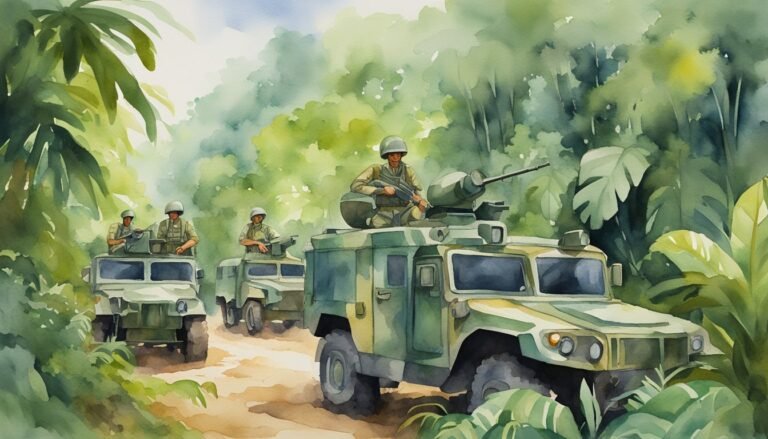
The military in the Philippines plays a crucial role in maintaining the country’s security and sovereignty. The Armed Forces of the Philippines (AFP) are composed of the Army, Air Force, and Navy, with the President serving as the Commander-in-Chief.
Each branch works together to respond to various threats and challenges, both domestically and internationally.
The AFP is continuously adapting to changes in technology and geopolitical dynamics.
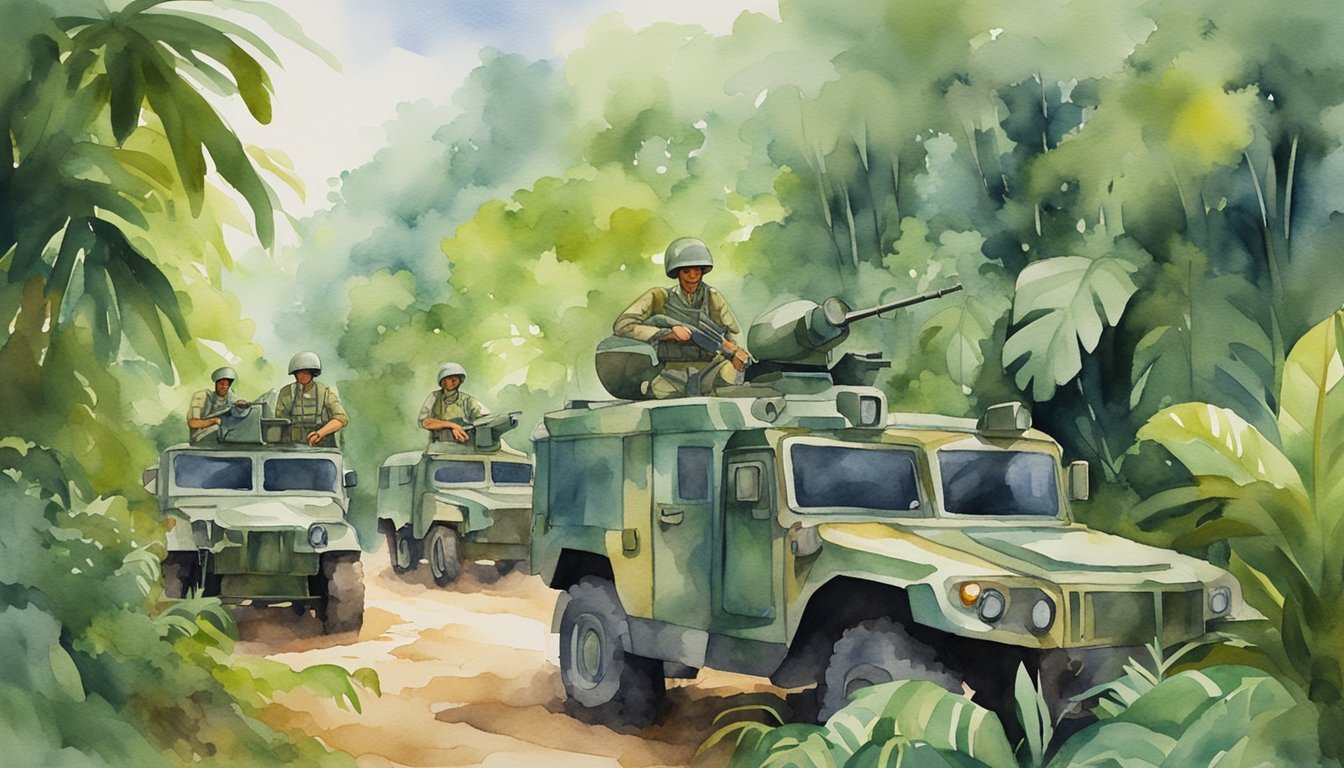
You might find it interesting that the United States has re-established its military presence in the Philippines through strategic agreements, aimed at countering regional threats.
This development marks a significant shift in the region’s defense landscape.
U.S. military bases are being set up in different areas, reflecting the longstanding relationship between the two nations.
The Philippine military also focuses on internal security challenges, such as insurgencies and natural disaster responses.
Training and education are key priorities to ensure that the armed forces remain effective and capable.
By understanding the structure and strategies of the AFP, you’ll gain a deeper appreciation for the efforts taken to protect the Philippines.
Key Takeaways
- The AFP includes the Army, Air Force, and Navy.
- U.S. military presence in the Philippines is growing.
- The AFP focuses on internal security and modernization.
Historical Background
The military in the Philippines has evolved through significant events, from the Philippine Revolution to modern conflicts.
These changes have shaped its structure and operations over time.
Formation and Early Years
The military in the Philippines traces its roots to the Philippine Revolution.
In 1897, the Philippine Revolutionary Army was established under General Emilio Aguinaldo.
This army played a crucial role in fighting Spanish colonial forces and later American occupation.
With the National Defense Act of 1935, the Philippines sought to form a structured military organization.
It set up a regular force of 10,000 soldiers and a substantial reserve force.
The setup aimed to create a defense system capable of protecting the country from external threats.
World War II and Post-War Developments
During World War II, the Philippine military faced intense challenges.
Japanese forces occupied the country, leading to significant battles and guerrilla warfare by Filipino soldiers.
After the war, the military focused on rebuilding and modernization.
Units like the Hukbalahap fought against Japanese occupation and continued to influence post-war military efforts.
This period also saw Philippine participation in international conflicts like the Korean and Vietnam Wars, where Filipino troops served alongside international allies.
Recent Conflicts and Peace Efforts
In recent decades, the military has been involved in various internal and external conflicts.
The Communist Insurgencies and the Moro Conflict in Mindanao have been significant challenges.
One notable event was the Battle of Marawi, where government forces battled ISIS-affiliated groups in 2017.
The military has also contributed to peacekeeping missions and has participated in operations in the Iraq War.
Efforts to bring peace include negotiations with insurgent groups and partnerships with international organizations to strengthen defense capabilities.
Structure of the Armed Forces of the Philippines
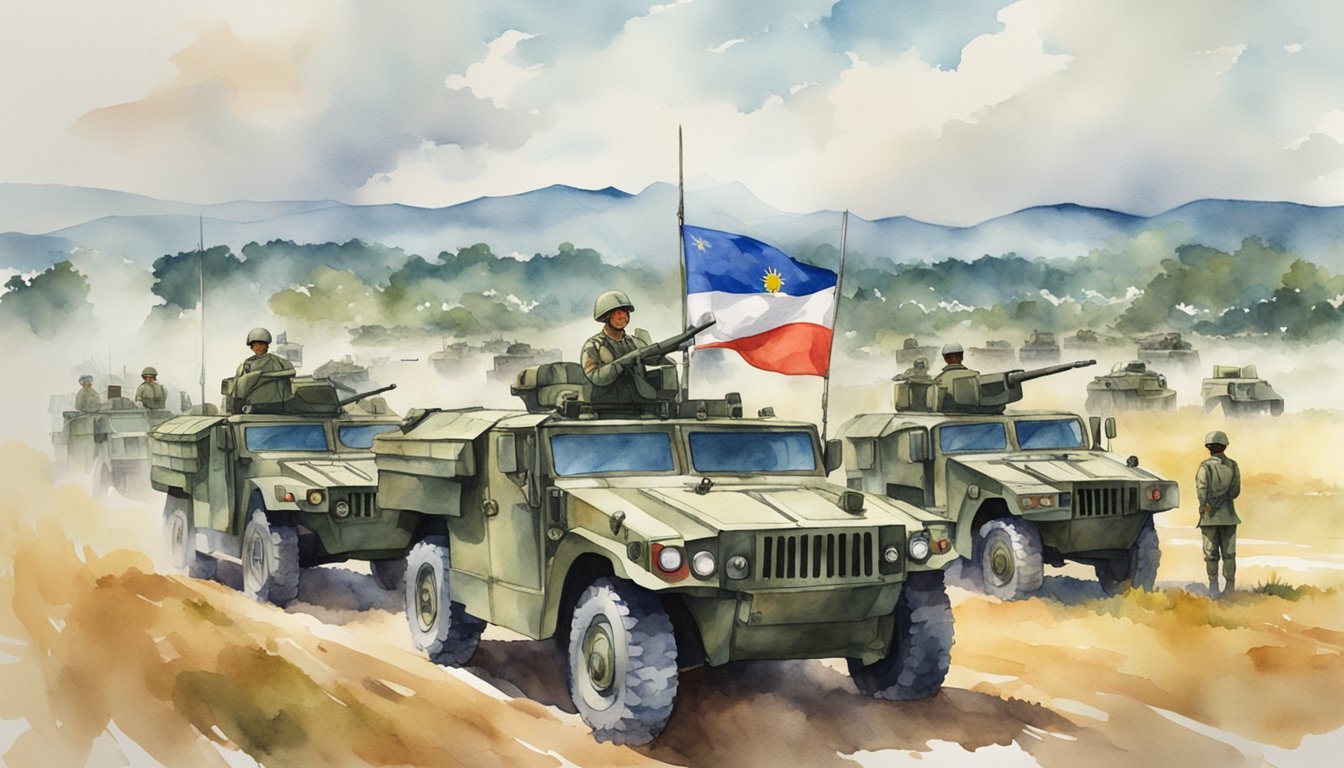
The Armed Forces of the Philippines are divided into several branches, each with its specific role and responsibility.
These branches include the Philippine Army, Navy, Air Force, and Marine Corps.
Philippine Army
The Philippine Army is the largest branch of the Armed Forces of the Philippines.
Its primary role is ground warfare.
It was established on December 21, 1935, and plays a key role in national defense and maintaining internal security.
The Army is divided into several units, such as infantry, artillery, armor, and engineering.
They also have Special Forces for specialized operations.
The main goal of the Army is to protect the country’s borders and fight insurgency.
It has around 143,100 active soldiers and over a million reserves ready to serve when needed.
For more details, visit the Philippine Army.
Philippine Navy
The Philippine Navy is responsible for naval operations and coastal defense.
It has three main components: the fleet, the Marine Corps, and the support units.
Established to secure the country’s waters, the Navy also engages in international missions and humanitarian efforts.
The Navy operates various ships, including frigates, corvettes, and patrol vessels.
They also have a naval aviation arm for air support.
The Navy ensures maritime security and helps during natural disasters.
Their primary mission is to safeguard the Philippines’ territorial waters, making them a vital part of the armed forces.
Learn more about the Philippine Navy.
Philippine Air Force
The Philippine Air Force focuses on aerial defense and air support.
It was established to provide air support during operations and to defend the airspace.
The Air Force operates fighter planes, transport aircraft, and helicopters.
Their roles include surveillance, disaster relief, and transportation of troops and supplies.
They also participate in international peacekeeping missions.
The Air Force is tasked with ensuring air superiority and providing aid in emergencies.
To read more, check out the Philippine Air Force.
Philippine Marine Corps
The Philippine Marine Corps is a part of the Navy but operates semi-independently.
They specialize in amphibious warfare, capable of fighting on land and sea.
Their training is rigorous to prepare for rapid deployment and specialized missions.
The Marines are often the first to respond to conflicts and emergencies.
They work closely with other branches for joint operations.
They also handle special operations and are key players in internal security.
Their versatility makes them an essential and highly valued branch of the armed forces.
Find more information about the Philippine Marine Corps.
The Armed Forces of the Philippines’ structure ensures a well-rounded defense system capable of addressing various threats and participating in global missions.
Defense Policies and Government Relations
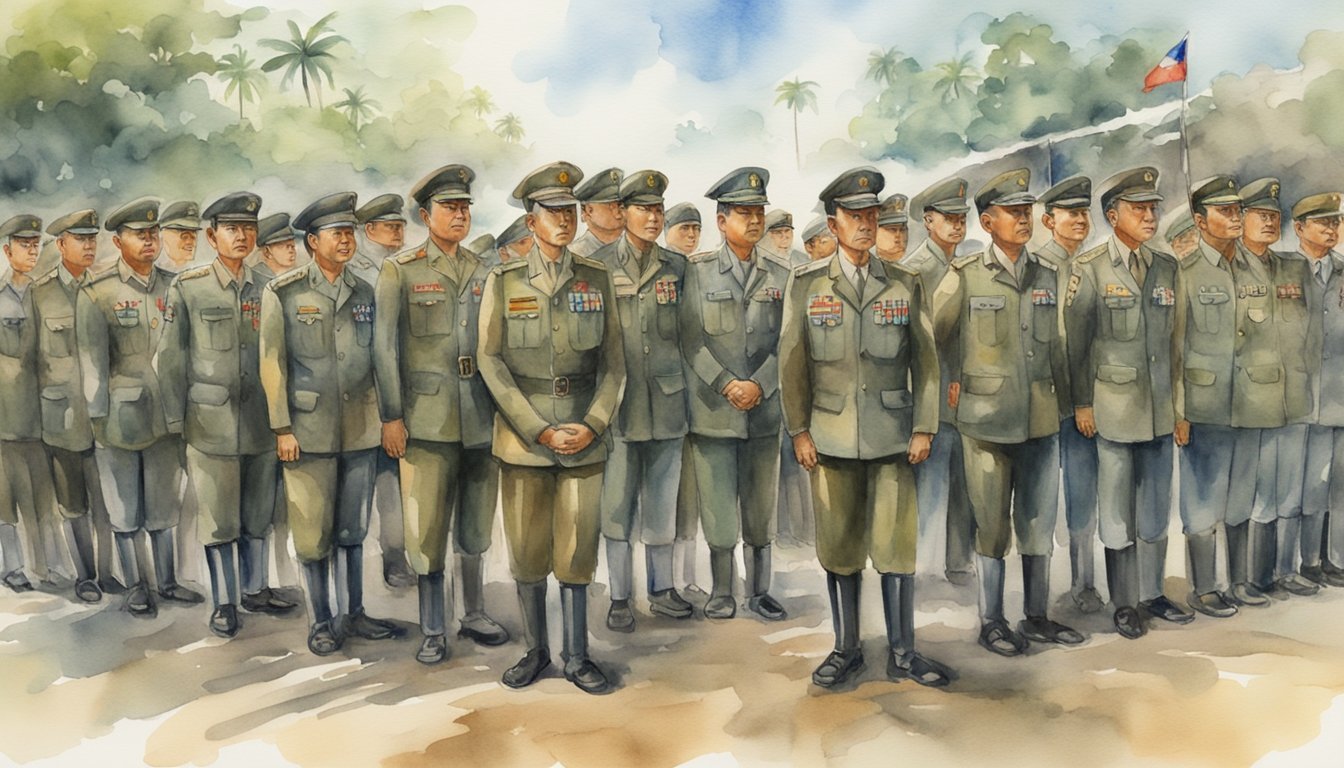
Philippine defense policies focus on strengthening national security, building cooperative relations between the military and civilians, and fostering international alliances.
National Military Strategy
The Philippine Government puts a lot of effort into shaping a robust military strategy.
The country’s military strategy has been evolving to address internal and external threats.
For instance, the establishment of the Bilateral Defense Guidelines in 2023 between the United States and the Philippines aims to strengthen military cooperation and readiness.
Recent updates to the Philippine Marine Corps’ operating procedures also signify a shift.
The 2021 updates, known as the AADS, have supported a paradigm shift in dealing with security challenges like those in the South China Sea.
This shift underscores the need for a modern, versatile force ready to engage on multiple fronts.
Civil-Military Cooperation
Civil-military cooperation is essential for maintaining public trust and ensuring effective disaster response.
The Philippine military often collaborates with civilian institutions in humanitarian assistance and disaster relief operations.
You might recall various situations where the military played a significant role in rescue operations during natural calamities.
Civil-military activities also include projects aimed at building infrastructure and providing medical services in rural areas.
This close cooperation helps build trust between the military and local communities, ensuring a united front against challenges.
International Alliances
International alliances are a crucial aspect of the Philippines’ defense strategy.
The long-standing military relationship between the United States and the Philippines is a cornerstone of this strategy.
Agreements such as the Mutual Defense Treaty (MDT) remain fundamental.
In 2023, an agreement granted U.S. forces access to additional military sites in the Philippines, enhancing the strategic presence in Southeast Asia.
Besides the U.S., the Philippines has ongoing engagements with the United Nations and neighboring countries like China, especially concerning territorial disputes in the South China Sea.
These alliances enable the Philippines to bolster its defense capabilities and maintain regional stability.
Training and Education
In the Philippines, military training and education are pivotal.
From intensive academy programs to mandatory training courses, these initiatives prepare individuals for various roles within the military.
Philippine Military Academy
The Philippine Military Academy (PMA) in Baguio City is where future officers are trained.
It’s known for its strict admissions and rigorous training.
To get in, you need to pass academic and physical tests.
Life at PMA is demanding.
You’ll go through a four-year program that includes academics, physical fitness, and leadership training.
Graduates earn a degree and a commission as a second lieutenant.
Reserve Officers’ Training Corps
The Reserve Officers’ Training Corps (ROTC) program is run in universities.
This program aims to teach young individuals military skills and leadership.
If you become a member, you’ll undergo both classroom lessons and practical exercises.
During the weekends or summer breaks, you may participate in field training exercises to simulate real military operations.
It’s designed to supplement the active military with a ready reserve force.
Basic Citizen’s Military Training
Basic Citizen’s Military Training (BCMT) is another avenue for military training in the Philippines.
It’s mainly aimed at civilians who are looking to support the armed forces.
This program covers basic military customs, drills, and skills.
The training can be intense but aims to ensure that participants are prepared to serve in times of national emergency or conflict.
Graduates of this program often go on to serve in various reservist roles.
Military Leadership
Military leadership in the Philippines is vital for maintaining order and effectiveness.
It is headed by various key offices and ranks, each with specific roles and responsibilities.
Office of the Chief of Staff
The Chief of Staff of the Armed Forces of the Philippines is the top military official.
This person is directly accountable to the President and oversees strategic planning and execution.
The current Chief of Staff ensures coordination among the different military branches—Army, Navy, and Air Force.
Assisting the Chief of Staff are the Vice Chief (LTGEN Charlton Sean M. Gaerlan) and the Deputy Chief (LTGEN Roy M. Galido), who handle operational and administrative matters respectively, ensuring smooth military functions.
The Commanding Generals
Each branch of the Armed Forces has a Commanding General who leads and manages their specific branch.
For example, LTGEN Stephen Parreño is the Commanding General of the Philippine Air Force, while the Army is headed by its own commanding leader.
These generals oversee training, resource allocation, and mission readiness.
They work together to implement policies outlined by the Chief of Staff and ensure each branch operates efficiently.
Their major responsibilities include reinforcing readiness, maintaining resources, and leading troops during missions.
Rank and File Structure
The rank and file structure is the backbone of military operations.
It consists of various ranks, starting from enlisted personnel like Privates and Corporals, climbing up to Sergeants and further to commissioned officers such as Captains and Colonels.
Higher ranks include Generals who play critical roles in decision-making.
A notable position is the Sergeant Major, who serves as a senior enlisted advisor, ensuring the welfare and training of enlisted soldiers.
This structure allows for clear hierarchy and command, which is crucial for discipline and order within the military.
Staying informed about these ranks and the organization helps you understand how military operations are efficiently carried out in the Philippines.
Each rank has specific duties, all contributing to the overall effectiveness and readiness of the Armed Forces.
Key Military Installations
The Philippines hosts several key military installations that are crucial for both national security and international cooperation.
Some of these bases have strategic importance due to their locations and facilities.
Camp Aguinaldo and Headquarters
Camp Aguinaldo in Quezon City is the main headquarters of the Armed Forces of the Philippines.
This base is essential as it holds the general headquarters and other key offices.
You will also find the Department of National Defense here.
One of its crucial roles is to coordinate operations across the Philippines.
It houses various training facilities and command centers.
Camp Aguinaldo is also involved in joint exercises with international allies, making it a hub for strategic military planning and coordination.
Located in Metro Manila, Camp Aguinaldo is accessible and plays a key role in city defense.
You might often hear about it in news reports related to military operations and national security.
Strategic Bases Across the Islands
There are several other important bases spread across the Philippine islands.
Some of the most notable include Subic Bay and Clark Air Base.
These bases, initially established by the United States, are now used by the Philippine military for various operations.
Subic Bay, in particular, is a deep-water port used for naval operations.
It is strategically located near the South China Sea.
This site is crucial for maritime security and international navy operations.
You might see this base mentioned often in discussions about regional security.
Another key base is Fort Magsaysay in Nueva Ecija.
This is one of the largest military reservations in the Philippines and is frequently used for joint exercises with the United States military.
It’s also a training ground for Philippine Army units.
These bases are not just military installations; they significantly contribute to both the national defense strategy and international military cooperation.
They are continually upgraded to meet modern defense requirements, making them pivotal to Philippine security.
Geopolitical Role in Southeast Asia
The Philippines plays a significant role in Southeast Asia, particularly through its military alliances and peacekeeping missions.
Key points include its involvement in territorial disputes and contributions to international peacekeeping efforts.
Territorial Disputes and Diplomacy
The Philippines is actively involved in territorial disputes in the South China Sea, especially the Spratly Islands and the West Philippine Sea.
These areas are crucial for their strategic location and potential resources.
China’s increasing influence in these territories has led to rising tensions.
You might know that the Philippines regularly conducts naval patrols and military exercises to assert its claims.
It also seeks alliances with other Southeast Asian countries and the United States to counter China’s activities.
Diplomatic efforts are just as important.
The Philippines uses forums like the Association of Southeast Asian Nations (ASEAN) to advocate for peaceful resolution of disputes.
By balancing military readiness with diplomatic actions, the country aims to protect its interests while avoiding conflict.
Participation in International Peacekeeping
The Philippines has a history of participating in international peacekeeping missions.
These missions are crucial for promoting global stability and showcasing the country’s commitment to international cooperation.
Filipino troops have been deployed under United Nations peacekeeping missions in various conflict zones.
These missions not only help maintain peace but also provide valuable experience for the military.
By participating, the Philippines strengthens its diplomatic relations and gains international respect.
Your country’s role in peacekeeping also supports its geopolitical strategy.
It helps to maintain a positive global image and reinforces alliances with key international players.
This participation enhances the Philippines’ influence in Southeast Asia and beyond, showing a commitment to global security and stability.
Current Security Challenges
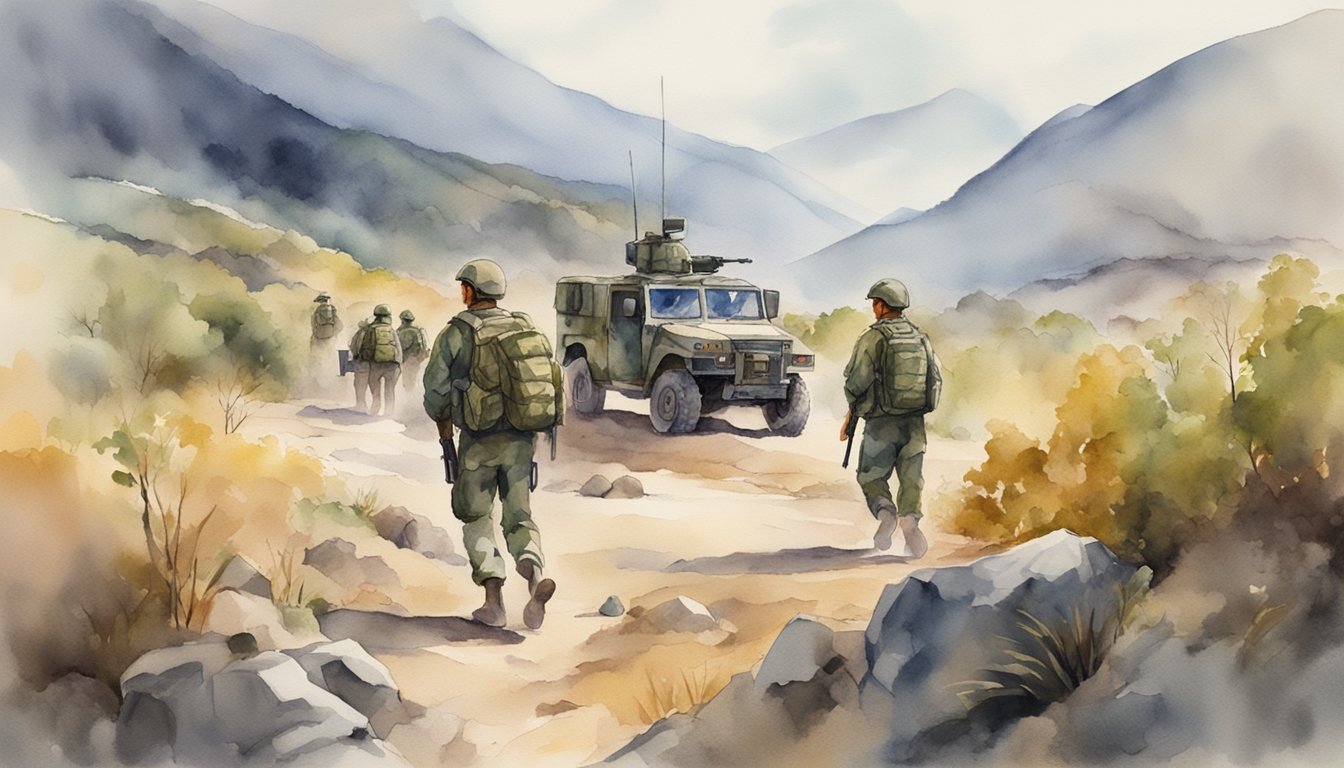
The Philippines faces many security challenges.
Insurgency and terrorism continue to trouble the nation, while natural disasters require frequent military assistance.
Insurgency and Terrorism
The country still deals with threats from the New People’s Army (NPA).
This group has been fighting the government for decades and often targets military posts.
The International Military Intervention against ISIL also affects the region.
Philippine troops often engage in skirmishes with terrorists in the southern parts of the country.
Mindanao is a hotspot for conflict, with groups like Abu Sayyaf causing unrest.
These insurgencies frequently disrupt peace and require the military’s constant vigilance.
The fight against these groups is ongoing, involving counter-insurgency operations that demand significant resources and focus.
Natural Disasters and Humanitarian Missions
The Philippines is prone to natural disasters such as typhoons, earthquakes, and volcanic eruptions.
You will often see the military leading disaster response efforts to help affected communities.
In these situations, the Armed Forces of the Philippines (AFP) often play a crucial role in rescuing people, providing medical aid, and distributing supplies.
They are also involved in rebuilding efforts after the immediate crisis has passed.
Humanitarian missions are essential in maintaining stability and peace during these challenging times.
The military’s quick response can make a big difference in saving lives and restoring normalcy.
These missions showcase the versatility and importance of the military beyond combat roles.
Military Modernization and Equipment
The Philippine military is undergoing significant changes to enhance its capabilities through modernization programs and new equipment acquisitions.
Asset Acquisition and Upgrade Programs
The Philippine government has approved a $35 billion military modernization plan, dubbed “Re-Horizon 3” (https://www.thedefensepost.com/2024/01/30/philippines-military-modernization-plan/).
This plan aims to enhance the military’s technological and structural capabilities over the next decade.
One key focus is on acquiring new equipment, such as naval vessels and aircraft, to improve maritime security.
This includes the purchase of modern frigates and patrol vessels to boost the navy’s operational reach.
Additionally, the army is receiving new transport and combat vehicles.
For example, 651 units of KM-450 trucks have already been purchased, with more acquisitions planned to support logistical operations.
Technological Advancements
Technological advancements play a crucial role in the Philippine military’s modernization efforts.
The modernization plan emphasizes integrating advanced technology into new and existing infrastructure.
The air force and navy are expected to benefit significantly from these advancements.
New aircraft and naval vessels will feature state-of-the-art navigation systems, radar, and communication technology.
To further enhance capabilities, the military is investing in cybersecurity and electronic warfare systems.
This ensures that the armed forces can respond effectively to both traditional and modern threats.
By focusing on both asset acquisition and technological advancements, the Philippine military aims to create a more robust and versatile defense system that can protect its national interests and maintain regional stability.
Public Perception and Trust
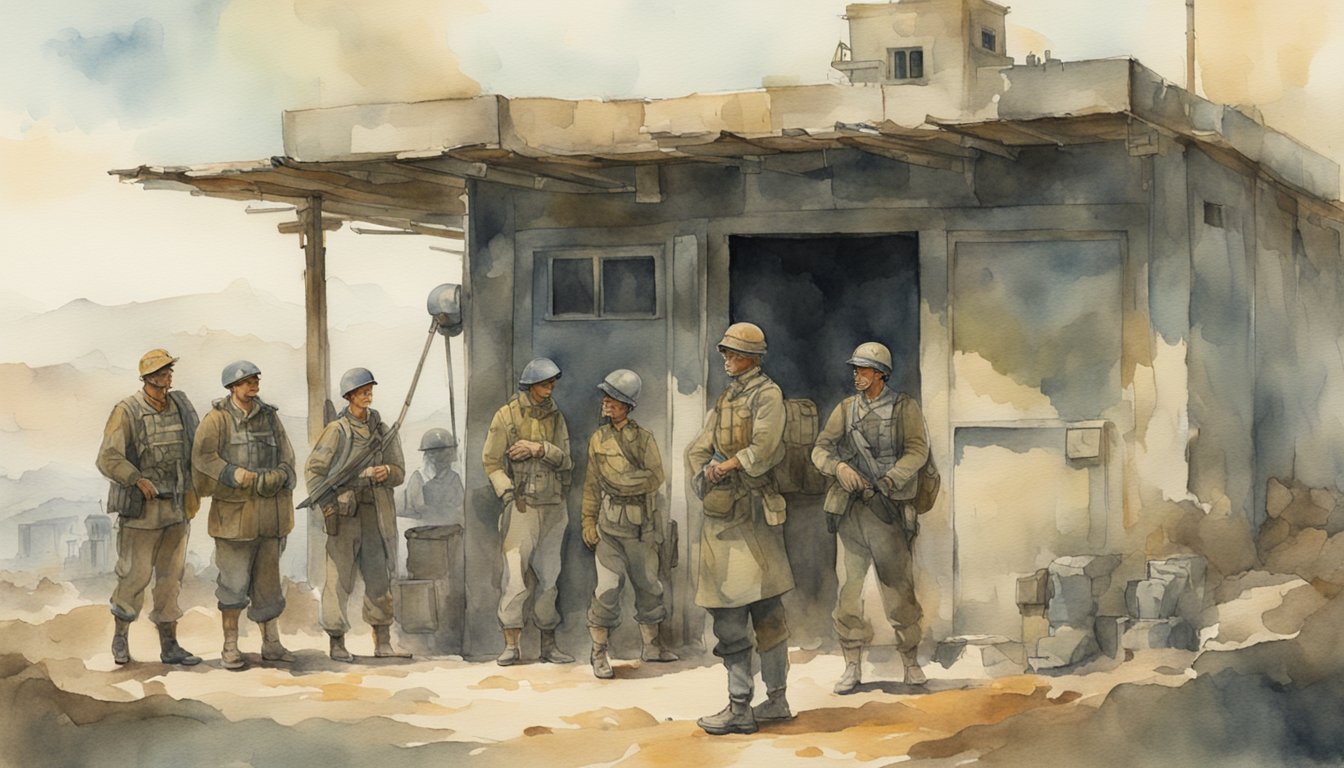
In the Philippines, the trust and perception of the military have seen notable changes over recent years.
Filipinos’ confidence in the Armed Forces of the Philippines (AFP) has hit new highs.
A survey in 2019 showed that public trust in the AFP was at its highest since polling started.
In early 2022, the military garnered the highest approval and trust ratings among all government agencies.
The AFP attributes this achievement to their increased professionalism and transparency.
Factors influencing this trust:
- Improved transparency
- Engagement with communities
- Acknowledgment of past mistakes
You might notice that other government bodies like the Bureau of Customs face more significant trust issues.
Allegations of corruption often affect how Filipinos perceive these agencies.
Compared to them, the military appears more reliable and transparent.
Trust Ratings Breakdown
| Year | Trust Rating (%) |
|---|---|
| 2019 | Highest rating since records began |
| 2022 | Topped trust ratings among government agencies |
The military’s open acceptance of past errors, particularly in Mindanao, has also played a role in changing public sentiments.
The Siege of Marawi and conflicts in the region have been learning points for the AFP.
You can see that national defense efforts have had a significant impact on how the public views the military.
By focusing on accountability and cooperation, the military has managed to boost public confidence substantially.
Frequently Asked Questions
In this section, you’ll find answers to common questions about the Philippine military.
These include how to find information on personnel, the official site for the Armed Forces, and details about different divisions and branches.
How can I find a complete list of army personnel in the Philippine Army?
Finding a complete list of army personnel in the Philippine Army isn’t publicly available due to security reasons.
For specialized inquiries, you may need to contact the Philippine Army directly through official channels.
Where can I access the official site for the Armed Forces of the Philippines?
You can visit the official site for the Armed Forces of the Philippines at www.armedforces.mil.ph.
Here, you’ll find updates, news, and information about their structure and activities.
What’s the global ranking of Philippine military power as of 2024?
As of 2024, the Philippine military ranks 51st globally in terms of military power.
This ranking takes into account various factors like budget, personnel, and equipment.
Does anyone know the total number of soldiers currently serving in the Philippines?
The total number of soldiers currently serving in the Philippine military is approximately 140,000.
This includes active duty personnel across all branches of the Armed Forces.
Could you break down the various infantry divisions within the Philippine Army?
The Philippine Army is divided into several infantry divisions.
These include the 1st Infantry Division (Tabak Division), the 2nd Infantry Division (Jungle Fighter Division), and the 3rd Infantry Division (Spearhead Division).
What are the different branches that make up the Armed Forces of the Philippines?
The Armed Forces of the Philippines is made up of the Philippine Army, the Philippine Navy (including the Marine Corps), and the Philippine Air Force.
Each branch has its own specific roles and responsibilities in national defense.






